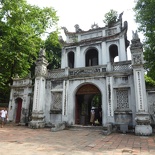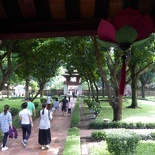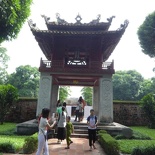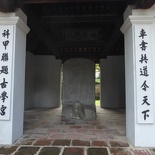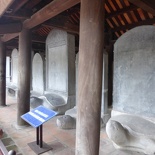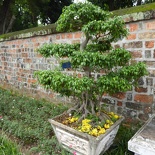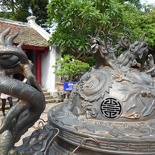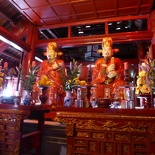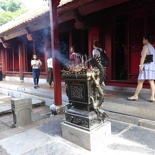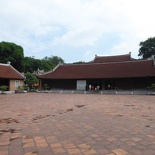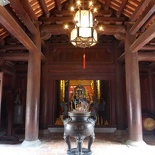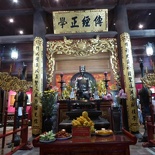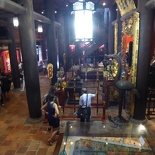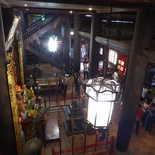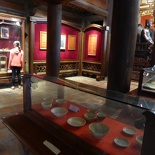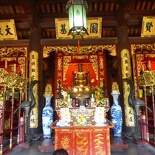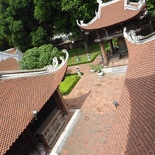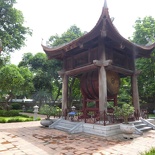Hanoi has a number of historical sites worth a visit during your stay in the city. They range from dreamy large temples such as the Temple of Literature and gloomy sites such as the Maison Centrale Prison site. Let’s take a look at Confucius Temple of Literature today.
The Confucius Temple of Literature
The Temple of Literature (Văn Miếu) is Vietnam’s first National University and is one of several temples in Vietnam which is dedicated to Confucius. It is almost a thousand years old, built in 1070 during the time of Emperor Lý Thánh Tông. Back then, Vietnam was ruled by the Emperors of the Lý dynasty.
The Lý Emperors looked to the Song Dynasty in China for inspirations and models for organizing a strong and centrally administered state. This means having a place to recruit and house sages and scholars. So they started examinations to choose minor officials and establish an imperial academy called “Quốc Tử Giám” in 1076.
First greeting you at the entrance of the old University compound is a large gate filled with intricate dragon and turtle cravings used to signify the “descending of the dragon/tiger” whenever a scholar graduates here to serve the people. A bronze bell above the gate complete with phoenix and dragon patterns representing the King and Queen was used to signify the entrance of an important person into the Temple of Literature.
The University is home to 4 large courtyards, which comprise of the bulk of the University compound. The first and second courtyards are large sparse green gardens which is a great welcome in Hanoi city, especially with the lack of green spaces. The third courtyard houses the Well of Heavenly Clarity, as well as rows of tablets housing Doctors Stelae.
Panorama of the Temple of Literature front Gardens
Stone Turtle Statues
One such stone figure is that of a turtle- one of Vietnam’s four holy creatures and is a symbol of longevity and wisdom. These stone statues were erected by King Lê Thánh Tông in 1484 to encourage a city culture of education. These statues were so highly sought after as “study good luck charms” by prospective university students, past and present that they are often flooded by them looking to pray and touch the statues for good luck in their exams, at times even damaging them in the process.
Hence, the situation became so dire that the temple had to resort to setting up boundaries like fences and stands to prevent people from touching and damaging the ancient statues. Today students can still get the blessings from the turtle statues, but from a distance. A great pond sits at the center of the turtle statue courtyard, home to what else, but turtles too!
Fourth temple Courtyard
Passing through The Gate of Great Success brings you into the Fourth temple Courtyard lined with beautiful hand-trimmed Bonsais. This is where the locals come in to pray for blessings with incense and offerings.
Panorama of the Fourth Inner Courtyard
The entrance gates to this courtyard too are vibrantly painted in red, detailed with intricate carving of dragons on them. These gateway entrances, like in typical Chinese fashion have a high step-in height (as a flood protection) to get across. This courtyard is probably the largest open concrete floored space you can find in the entire temple grounds too. These are flanked by two surrounding halls housing souvenir shops and drinks stalls for a tea break or two.
Furthermore, the souvenir shops do sell a number of attraction-unique souvenirs, postcards and hand cravings. This includes a selection of standard tourist gifts at reasonable rates too. The building at the far end houses altars to the seventy-two most honored disciples of Confucius and Chu Văn An.
There are two parts of this fourth courtyard building. There is one main building and a second connecting building behind this first called the Dai Thanh Sanctuary. It is connected via an inter-linking and sheltered covered walkway lined by wooden doors with an incense altar at the walkway center.
Dai Thanh Sanctuary and artifacts
Moreover, the Dai Thanh Sanctuary building is a two-floored building housing a collection of several artifacts as well as a Confucius altar. The ground floor is fronted by the altars of Confucius and his four closest disciples Yanhui, Zengshen, Zisi and Mencius. Visitors are free to enter to offer your blessings.
While the first building is open and lit, the inner Sanctuary building on the contrary here is cladded in dark wood. This, together with the lingering incense smoke in the building does gives the interior here more dreamy and a much darker contrast outlook.
A cove of artifacts
In addition of the Confucius altars sitting at the center of the building, the sides of the halls houses cabinets and table displays of various artifacts, inscriptions, pottery and weapons on display. There is even a large official signboard of the Temple where visitors can have a photo moment with.
Furthermore, the upper floors of the Dai Thanh Sanctuary is home to another set of altars, which you can access via two high flanking wooden staircases on both sides of the building lower ground floor. Interestingly, the staircases look as if they are assembled together without a nail in sight. The top second floor is also home to a small loft and balcony, offering an elevated view of the temple grounds, though most of the view is covered by the roof of the adjacent buildings.
Surrounding the Dai Thanh Sanctuary is a small perimeter of green garden space flanked by the Temple’s outer concrete perimeter high walls where the city streets of Hanoi reside beyond. This small garden is also home to a small a drum tower and the rear temple exit back onto the streets.
In all, you are good at the temple of literature for an hour or two. Is it a rather small compound sheltering you from the chaotic and busy streets of Hanoi. One of the must-see attractions not just for its history but internal beauty too.
Lastly, you can view more photos of Confucius Temple of Literature in its own photo gallery.

